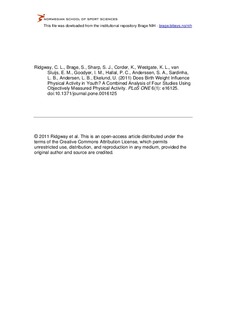| dc.contributor.author | Ridgway, Charlotte L. | |
| dc.contributor.author | Brage, Søren | |
| dc.contributor.author | Sharp, Stephen J. | |
| dc.contributor.author | Corder, Kirsten | |
| dc.contributor.author | Westgate, Kate | |
| dc.contributor.author | van Sluijs, Esther M. F. | |
| dc.contributor.author | Goodyer, Ian M. | |
| dc.contributor.author | Hallal, Pedro C. | |
| dc.contributor.author | Anderssen, Sigmund A. | |
| dc.contributor.author | Sardinha, Luis B. | |
| dc.contributor.author | Andersen, Lars Bo | |
| dc.contributor.author | Ekelund, Ulf | |
| dc.date.accessioned | 2012-04-11T07:53:44Z | |
| dc.date.available | 2012-04-11T07:53:44Z | |
| dc.date.issued | 2011-01-12 | |
| dc.identifier | Seksjon for idrettsmedisinske fag / Department of Sports Medicine | |
| dc.identifier.citation | PLoS ONE. 2011, 6(1), e16125 | no_NO |
| dc.identifier.issn | 1932-6203 | |
| dc.identifier.uri | http://hdl.handle.net/11250/170877 | |
| dc.description | © 2011 Ridgway et al. This is an open-access article distributed under the terms of the Creative Commons Attribution License, which permits unrestricted use, distribution, and reproduction in any medium, provided the original author and source are credited. | no_NO |
| dc.description.abstract | Animal models suggest growth restriction in utero leads to lower levels of motor activity. Furthermore, individuals with very low birth weight report lower levels of physical activity as adults. The aim of this study was to examine whether birth weight acts as a biological determinant of physical activity and sedentary time. This study uses combined analysis of three European cohorts and one from South America (n = 4,170). Birth weight was measured or parentally reported. Height and weight were measured and used to calculate Body Mass Index (BMI). PA was objectively measured using accelerometry for ≥3 days, ≥10 hours day. Data was standardized to allow comparisons between different monitors. Total physical activity was assessed as counts per minute (cpm), with time spent above moderate activity (MVPA) >2,000 counts and time spent sedentary (<100 counts). There was no evidence for an association between birth weight and total physical activity (p = 0.9) or MVPA (p = 0.7). Overall there was no evidence for an association between birth weight and sedentary time (p = 0.8). However in the Pelotas study we did find an association between higher birth weight (kg) and lower overall physical activity (cpm) (β = −31, 95%CI: −58, −46, p = 0.03) and higher birth weight and greater sedentary time (mins/day) (β = 16.4, 95%CI: 5.3, 27.5, p = 0.004), although this was attenuated and no longer significant with further adjustment for gestational age. Overall this combined analysis suggests that birth weight may not be an important biological determinant of habitual physical activity or sedentary behaviour in children and adolescents. | no_NO |
| dc.language.iso | eng | no_NO |
| dc.publisher | PLoS ONE | no_NO |
| dc.subject | adolescent | no_NO |
| dc.subject | birth weight | no_NO |
| dc.subject | body mass index | no_NO |
| dc.subject | Europe | no_NO |
| dc.subject | humans | no_NO |
| dc.subject | motor activity | no_NO |
| dc.subject | physiology | no_NO |
| dc.subject | sedentary lifestyle | no_NO |
| dc.subject | South America | no_NO |
| dc.title | Does birth weight influence physical activity in youth? a combined analysis of four studies using objectively measured physical activity | no_NO |
| dc.type | Journal article | no_NO |
| dc.type | Peer reviewed | no_NO |
| dc.subject.nsi | VDP::Mathematics and natural science: 400::Basic biosciences: 470 | no_NO |
| dc.subject.nsi | VDP::Agriculture and fishery disciplines: 900::Agriculture disciplines: 910 | no_NO |
| dc.source.pagenumber | e16125 | no_NO |
| dc.source.volume | 6 | no_NO |
| dc.source.journal | PLoS ONE | no_NO |
| dc.source.issue | 1 | no_NO |
